

|
Essays on the Marshallese Past
Traditional Land Management in the Marshall Islands |
We will have a brief look at the traditional lay-out of a land allotment
In the traditional way of setting out the land, a household would own a wato running from the lagoonal to the ocean shore. The vegetation pattern would show a clear zonation and sorting of plants from the lagoon to the ocean shore which is correlated to the soils and the wind action; thus, having a slice of land running from shore to shore allowed people to have access to all types of resources. Only in more recent times, when the population increased to the maximum the atolls could carry, the land allotments became split, with some families having no land bordering the lagoon or the ocean.
Let us take an imaginary walk through one such wato, and let us start at the ocean side. The vegetation on the oceanside commonly consisted of a mixed broadleaf forest, with a few tree species and a number of shrubs, usually
Going inland, the soil would gradually become finer, first gravel and then coarse grained sand, and the humus content would increase. In this zone an abundance of breadfruit trees would have been planted, providing food. In fact the trees were planted in such an abundance that we can speak of a breadfruit forest.
In the very centre of the island, there where the underlying ground water lens would be the thickest, taro patches, artificial depressions in the ground, would be present. These taro patches, in which swamp taro
These Pandanus would act as a windbreak for the large taro leaves, and would also act as screen to filter out any salt spray the winds may bring. We have to imagine that every piece of ground in the centre would have been taken up by taro patches, Pandanus plants and roads/tracks. Going further towards the lagoonal shore the vegetation zonation would once again show a wide zone of breadfruit forests which would make way to utility and ornamental shrubs along the rear side of the household units.
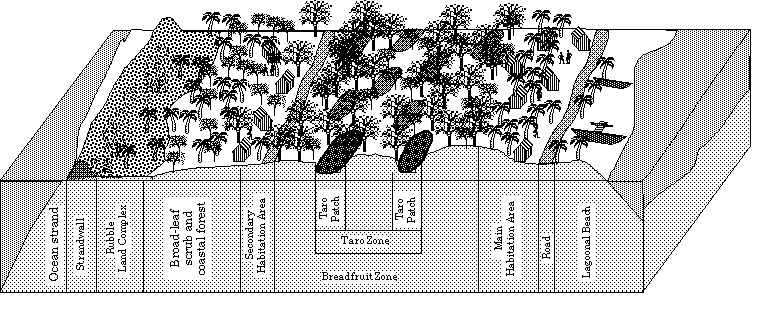
Typical traditional vegetation zonation pattern of an inhabited large, leeward atoll islet.
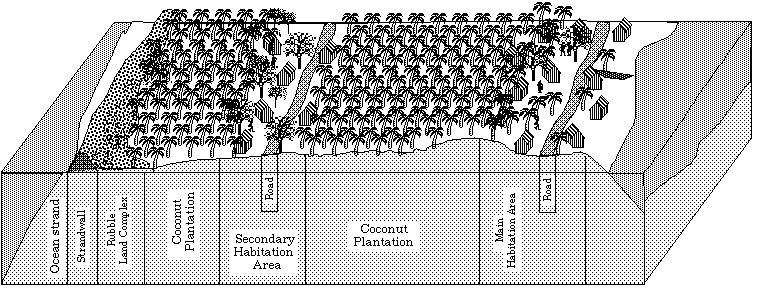
Typical modern vegetation zonation pattern of a leeward atoll islet.
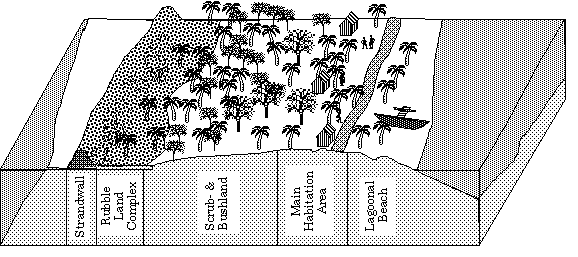
Typical vegetation zonation pattern of an inhabited windward atoll islet.
In this area we have to imagine the cemeteries. In view of the limitations on available land only the higher ranking people would be buried, while the bodies of the commoners were pushed out to sea. Next would come the coral gravel spreads on which the houses were built. The houses would have a cook house, as well as a rubbish dump in the rear. Towards the lagoonal shore, the "show-side" of the houses, there would be a sand-covered road, and then a low shrub or weed zone with some coconut. This zone provided access to the lagoon and allowed canoes to be dragged above the high-tide mark. The uninhabited and uncleared stretches of the lagoonal shores would show a coconut shrubland with an abundance of
Such a lay-out of a wato did not come about by itself. If one wants to see largely unmodified but fertile islands, as little as there are left in the Republic, then one should go to
If we have a look at
In the beginning it was mentioned that in the traditional way of setting out the land, a household would own a wato running from the lagoonal to the ocean shore to allow access to all types of resources. When the families grew beyond the size of cohesiveness, then the land allotment would be split in the middle, making it more narrow. One can do this for some time, but then comes the point that this is no longer sensible and the allotment is split into an ocean and a lagoon part. Those owning the ocean half of the former wato, then had to build a new house. In order to waste as little fertile land as possible, the house was built at the fringe of the breadfruit zone, between the breadfruit zone and the coastal forest. So a second row of houses developed over time. There is an abundance of archaeological sites at this very line, clearly demarcating the former and present settlement area. The road, as we know it, is merely a creation of the
What then, is the difference between the European and traditional lay-out of the land? With the Europeanisation of the Marshallese agroforestry, copra production became the driving economic force and as much land as possible was placed under coconut. Thus a systematic replacement of breadfruit forests by coconut plantations for copra production took place. The German and Japanese wide-spaced coconut plantations penetrated far inland, where coconuts would have never occurred naturally. Thus, islands, coconut studded throughout, are a European invention.
The large islands represent over 2000 years of careful and systematic improvement in order to maximize the return of the land. Unfortunately many large islands, because of their size, have seen large scale development and destruction of all these fruit trees and taro patches. It began with the establishment of the German copra plantations, then the large-scale land clearings necessary for the establishment of the Japanese military bases on
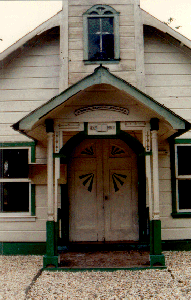
Use of local wood then and now. Top: Marshallese church on Ebon Island, built of breadfruit (Artocarpus). Bottom: top end of an aje drum made of jon (?) wood with a drum lining made from a shark's stomach. Collected in the 1880s in Jaluit (Knappe Collection; photographs Courtesy of Museum fÎr ThÎringer Volkskunde, Erfurt).
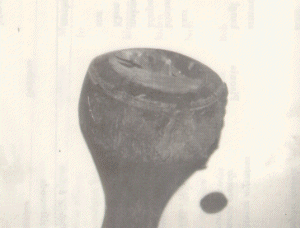
| Name | Edible parts | ||||
| Scientific | Common | Marshallese | Normal times | Emergency | |
| Giant taro | babai | Tubers | |||
| Breadfruit (w. seeds) | mà | Fruit, Seeds | |||
| Breadfruit (no seeds) | mà | Fruit | |||
| armwe | Leaves, grated wood | ||||
| Coconut | ni | Nuts, Sap, | old wood | ||
| Spider lily | kieb | Roots, Stem | |||
| Swamp taro | jaraj | Tubers | |||
| Grated wood | |||||
| Banana | binana | Fruit | |||
| Pandanus | böb | Keys (Pulp) | Keys (Seeds), Roots, Bark Sap | ||
| Arrowroot | makmök | Tubers | |||
| ata | Leaves, grated wood | ||||
| markubwebwe | Leaves, grated wood |
| Name | |||
| Scientific name | Common name | Marshallese | Edible parts |
| cabbage | kapej | leaves | |
| pawpaw, papaya | kenapu | Fruit | |
| Dry-land taro | kötak | Tubers, Leaves | |
| Squash | baanke | Fruit | |
| Sugarcane | to | Stem |
| Name | |||
| Scientific | Marshallese | Utilised parts | Used for |
| KÎtaak | leaves | Physical energiser for children; general body massage | |
| Leaves | General healing plant | ||
| Jo™ | Bark | Against fish poisoning | |
| WÎlej | Young leaves | Psychic energiser | |
| Ni | Sheath | Broken limbs (support) | |
| Kieb | Trunk | Splintered limbs (support) | |
| Leaves | Headache | ||
| Utilomar | Flower | Purgative; headache | |
| Kadjo | Leaves | General pain relief | |
| Kiden | Root | Fall | |
| Nen | Flower, leaves | Stomach pain relief; treatment after having given birth | |
| Young leaves & bark | Gonorrhea | ||
| Köbjar | Peel/skin | Energiser | |
| Böb | Sap | Treatment for coitus captivus | |
| Kangl | Leaves | Open wounds; purgative | |
| Kino | Leaves | Headache | |
| Kaar | Leaves | Weakness of limbs; headache | |
| Tirooj | Young leaves | Headache | |
| Könnat | Young leaves | Psychic energiser | |
| Leaves | Treatment after having given birth | ||
| Atat | Leaves | Cuts, open wounds | |
| Young leaves & bark | Gonorrhea | ||
| Markubwebwe | Flowers | Psychic energiser | |
| Related uses | |||
| Wöb | Seeds | Fish poison |
| Name | ||||
| Scientific | Common | Marshallese | Utilised parts | Used for |
| kedak | stem | fishing pole | ||
| Breadfruit | MÃ | wood | canoe hulls outrigger floats, | |
| canoe bailers, Pandanus (legs), | ||||
| food bowls, drums, graters (legs), | ||||
| weaving panels | ||||
| sap | glue (for canoe caulking) | |||
| armwe | stems | cordage, men's skirts (chiefs), | ||
| nets, sowing thread | ||||
| Mangrove | Jo™ | wood | dancing spears, fishing spears, house construction, | |
| canoes (sacrificial keel), canoes | ||||
| (outrigger assembly: kie, apit, kein-eon erre), copra huskers | ||||
| young stems | fishtraps, arrowroot sieves (waliklik) | |||
| bark | dye, cordage/rope, fishing nets | |||
| propagules | dye | |||
| lukwej | wood | beaters, pounders (for breadfruit), canoes | ||
| (outrigger assembly: kie, apit) | ||||
| kaönön | vines | sieve (for arrowroot) | ||
| Coconut | Ni | wood | houses, fishing spears, spears (weapons) | |
| frond skin | weaving | |||
| frond stems | stickcharts | |||
| fronds | thatching, floor cover of houses | |||
| leaves | baskets, weaving (mats) | |||
| leaf cloth | sieve (for arrowroot), | |||
| (spathe) | fishing gear (lure/bait | |||
| husks | rope, men's skirts, fishing line, | |||
| line to tie canoe parts, fishing | ||||
| nets, netyss for breadfruit cleaning, | ||||
| belts, sanitary pads, sling shots, | ||||
| caulking material for canoes | ||||
| shell | fishing gear (float), fish | |||
| hook, containers (flour, water etc.), | ||||
| cups, bowls, ladles, to scrub clothes, | ||||
| Pandanus scrapers (bowls), beads | ||||
| (for necklaces) | ||||
| shell (burnt) | dye | |||
| köno | stems | men's skirts | ||
| wood | Canoes (outrigger assembly: apit & kie) | |||
| wut | wood | fire plow, |
||
| Pinpin | wood | fishing gear (net handles), canoe ornaments, canoes | ||
| (parts of the outrigger assembly) | ||||
| lo | stems (bark) | men's skirts, fishing line, fishing nets, belts, fishing gear | ||
| (blinkers), weaving (ornamenÁtation for mats) | ||||
| Mangrove | kimeme | wood | Canoes (outrigger assembly: apit & kie), | |
| canoes (sacrificial keel piece) | ||||
| Tournefortia | kiden | wood | Canoes (outrigger assembly: apit & kie) | |
| Nen | roots | dye (red) | ||
| Banana | leaves | fibres | ||
| Pandanus | Böb | leaves | weaving (mats, sails, fans, hats, | |
| belts), thatching, baskets, mat bags, | ||||
| caulking (canoes), balls, ear ornaments, | ||||
| fishing gear (blinkers), sling shots, sanitary | ||||
| pads | ||||
| wood | neck rests | |||
| aerial roots | fishtraps, wall covers of houses, | |||
| arrowroot sieves (waliklik), putty | ||||
| for caulking canoes (scrapings from | ||||
| the roots) | ||||
| roots | (sap) tanning of drum typana | |||
| kö™e | wood | Pandanus scrapers (legs), beaters, | ||
| caulking chisels, canoes | ||||
| (outrigger assembly: apit & kie), | ||||
| fish traps, pounders (for breadfruit) | ||||
| armwe | stalks | fibres, cordage, fishing lines | ||
| Pisonia | kangl | wood | house construction, drums, copra | |
| huskers, head-shaped forms for hat weaving | ||||
| root | shark hook, parts of fish traps | |||
| kaar | stem | fishing pole | ||
| Scaevola | könnat | wood | canoes (outrigger assembly: kie, apit) | |
| Mangrove | könpat | wood | canoes (sacrificial keel piece) | |
| Arrowroot | makmök | stems | weaving (hats) | |
| Kkon | wood | canoes (outrigger assembly: kie, apit) | ||
| atat | stems | light cordage, men' s skirts, belts, fine weaving | ||
| roots | brown dye | |||
| markubwebwe | ||||
| Driftwoods | ||||
| Bamboo | stems | containers (needles, glowing coals | ||
| etc.), spears (weapons, fishtraps | ||||
| (slithers) | ||||
| kÃmej | wood | canoe hulls, drums |
| select from the following... | ||||||
| |
||||||
|
Digital Micronesia-An
Electronic
Library & Archive
is provided free of charge
as an advertising-free
information service
for the world community. It is being maintained by Dirk
HR Spennemann, Associate
Professor in Cultural
Heritage Management, Institute of Land, Water and Society and School
of Environmental & Information Sciences, Charles
Sturt University,
Albury, Australia. The server
space and technical support are provided by Charles
Sturt University as part of its commitment
to regional engagement. Environmental
SciencesInformation
Sciences
|
||||||